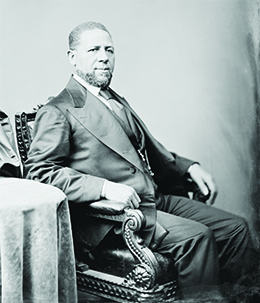| << Chapter < Page | Chapter >> Page > |
The political activities of the leagues launched a great many African Americans and former slaves into politics throughout the South. For the first time, blacks began to hold political office, and several were elected to the U.S. Congress. In the 1870s, fifteen members of the House of Representatives and two senators were black. The two senators, Blanche K. Bruce and Hiram Revels, were both from Mississippi, the home state of former U.S. senator and later Confederate president Jefferson Davis. Hiram Revels ( [link] ), was a freeborn man from North Carolina who rose to prominence as a minister in the African Methodist Episcopal Church and then as a Mississippi state senator in 1869. The following year he was elected by the state legislature to fill one of Mississippi’s two U.S. Senate seats, which had been vacant since the war. His arrival in Washington, DC, drew intense interest: as the New York Times noted, when “the colored Senator from Mississippi, was sworn in and admitted to his seat this afternoon . . . there was not an inch of standing or sitting room in the galleries, so densely were they packed. . . . When the Vice-President uttered the words, ‘The Senator elect will now advance and take the oath,’ a pin might have been heard drop.”

Hiram R. Revels became the first African American to serve in the U.S. Senate in 1870. In 1871, he gave the following speech about Washington’s segregated schools before Congress.
Will establishing such [desegregated] schools as I am now advocating in this District harm our white friends? . . . By some it is contended that if we establish mixed schools here a great insult will be given to the white citizens, and that the white schools will be seriously damaged. . . . When I was on a lecturing tour in the state of Ohio . . . [o]ne of the leading gentlemen connected with the schools in that town came to see me. . . . He asked me, “Have you been to New England, where they have mixed schools?” I replied, “I have sir.” “Well,” said he, “please tell me this: does not social equality result from mixed schools?” “No, sir; very far from it,” I responded. “Why,” said he, “how can it be otherwise?” I replied, “I will tell you how it can be otherwise, and how it is otherwise. Go to the schools and you see there white children and colored children seated side by side, studying their lessons, standing side by side and reciting their lessons, and perhaps in walking to school they may walk together; but that is the last of it. The white children go to their homes; the colored children go to theirs; and on the Lord’s day you will see those colored children in colored churches, and the white family, you will see the white children there, and the colored children at entertainments given by persons of their color.” I aver, sir, that mixed schools are very far from bringing about social equality.”
According to Senator Revels’s speech, what is “social equality” and why is it important to the issue of desegregated schools? Does Revels favor social equality or social segregation? Did social equality exist in the United States in 1871?

Notification Switch
Would you like to follow the 'U.s. history' conversation and receive update notifications?